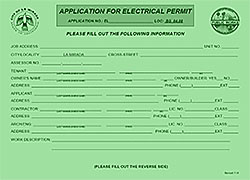Hot Tub Wiring

Installing a new hot tub? Wiring for a full-featured portable hot tub has to be done correctly, as we all know that water and electricity don't mix. In most cases, a 50 or 60 amp breaker provides power to a secondary GFCI box, which powers the spa pack controller. When wiring a hot tub, it's best to play it safe - hire an electrician and pull a permit so you can be sure it's all up to code.
PERMITTING A HOT TUB
Do you need a permit for a hot tub? Probably. Most local building and zoning boards want to certify that hot tub wiring has been done safely, properly and "up to code." The permit-inspection-approval process helps prevent unsafe spa wiring, which can result in electrocution and fire.

Having an inspector certify the work ensures that electricians don't cut corners like using small wire size, cheap connectors, incorrect or absent conduit, or ignoring important safety regulations. It also ensures that your contractor is licensed in your state to perform hot tub wiring.
Wiring a hot tub is best left to licensed electricians that have experience working with Article 680.42, and with local electrical inspector interpretations of the code, which can vary. Avoid using anyone other than a licensed and established electrician. If they tell you that you don't need a permit, run for the hills and find another contractor! Remember, it's for your own protection and safety.
WIRING A HOT TUB
There are plug-n-play hot tubs that you can literally plug into a 15 amp wall outlet. However, if you want a tub with powerful equipment and features, these require hard-wiring to a 50 or 60 amp breaker on a dedicated circuit (nothing else powered by the breaker).
The first question is, do you have enough room (spare amperage) in your existing home breaker panel to add a rather large 50 amp circuit breaker? Add up the amps listed on the breaker handle and compare that number to the label at the top of the panel, which tells how many amps the panel supports in total (usually 100, 200 or 400 amps).
The second thing to consider is how far away from the home's breaker panel you want to place the spa. You will need to run four wires in conduit from the new circuit breaker to the GFCI power connection in the spa pack. A secondary GFCI power cut-off outside of the spa (at least 5 feet from the spa) is connected to the breaker in the main home breaker panel. Many electricians like to use a square D 50-amp GFCI panel, shown right.
Once you get power into the spa from a dedicated circuit, the four wires (ground, neutral, hot 120V, hot 120V) will connect directly into your spa pack. Consult your owner's manual for specific connections and settings, accessed inside the control box. Once connected, follow your particular spa instructions for filling and starting up your new spa pack.
BONDING A HOT TUB

Bonding for hot tubs is an important part of electrical safety. A bare copper wire is attached to bonding lugs on metal and electrical spa equipment. Bonding captures stray voltages or short circuits that any one load (pump, blower, heater) may be producing. The large gauge bare copper wire creates an easy pathway for fault currents to flow, to protect spa users from electric shock.
Equipotential bonding is another type of bonding that connects a body of water (pool or spa) to the rebar steel used in the pool deck. In 2014, the NEC amended Article 680.42 to permit spa and hot tub installations without equipotential bonding, but with these exceptions:
- Must be listed as a "Self Contained Spa" on the certification label.
- It cannot be listed as "For Indoor Use Only" on the certification label.
- It must be installed according to the manufacturer’s instructions.
- It must be installed 28" above any surface within 30" of the tub.
